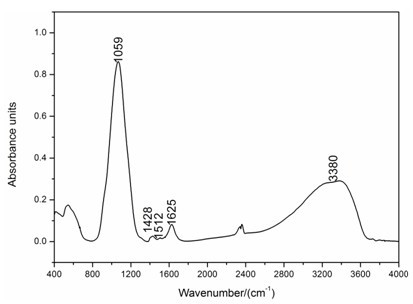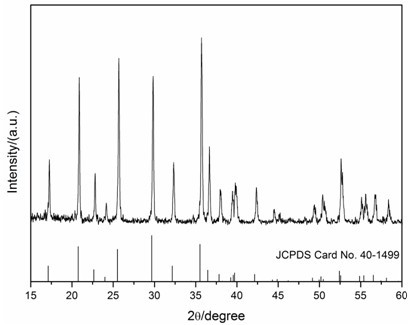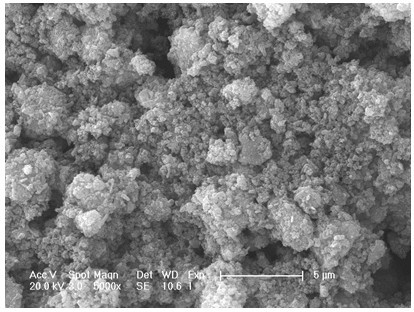Process for preparing LiFePO4/C composite cathode material by precursor in-situ polymerization-carbothermic process
A composite cathode material, in-situ polymerization technology, applied in battery electrodes, electrical components, circuits, etc., can solve the problems of uneven carbon coating, can not greatly improve the rate performance of composite cathode materials, etc., to achieve the effect of strong conductivity
- Summary
- Abstract
- Description
- Claims
- Application Information
AI Technical Summary
Problems solved by technology
Method used
Image
Examples
Embodiment 1
[0030] 3.4509g NH 4 h 2 PO 4 and 12.12g Fe(NO 3 ) 3 9H 2 O was made into a 100mL aqueous solution, both were added to a 500mL round bottom flask, mixed with 0.5mL aniline using a pipette, and mechanically stirred evenly. Then use the dropping funnel to slowly drop into 50 mL of 5 mL of 30% H 2 o 2 , adding ammonia and HCl to adjust the pH of the solution to 1.78. After the reaction continued for 24 hours, the obtained precipitate was suction-filtered, washed twice with acetone and deionized water, and then dried at 100° C. for 2 hours by air blowing and 50° C. for 12 hours under vacuum. FePO will be obtained 4 / PAn (polyaniline) composite material and 1.2588g LiOH·H 2 O mixing, using ethanol as a dispersant in a QM-3SPO4 planetary ball mill at 300r / min for 6h. Then the ball-milled mixture was dried at 60°C and ground, then moved into a QTL1200 tube furnace, raised to 400°C at a heating rate of 5°C / min in an atmosphere of 20 mL / min high-purity Ar (99.999%) and kept fo...
Embodiment 2
[0032] 3.0195g NH 4 h 2 PO 4 and 6.757g FeCl 3 ·6H 2 O was made into 100mL aqueous solution, both were added into a 250mL round-bottomed flask, mixed with 0.6mL pyrrole using a pipette, and mechanically stirred evenly. Then use the dropping funnel to slowly drop into 50mL containing 5.7005g (NH 4 ) 2 S 2 o 8 aqueous solution, adding ammonia and HCl to adjust the pH of the solution to 1.5. After the reaction continued for 12 hours, the obtained precipitate was suction-filtered, washed once with acetone and deionized water, and then dried at 100° C. for 2 hours by air blowing and 50° C. for 12 hours under vacuum. FePO will be obtained 4 / PPy (polypyrrole) composite material and 0.9236g Li 2 CO 3 Mix, and use ethanol as a dispersant to mill in a QM-3SPO4 planetary ball mill at 200r / min for 12h. Then the ball-milled mixture was dried at 60°C and then ground, and then placed in a QTL1200 tube furnace, at 40mL / min high-purity N 2 (99.999%) in the atmosphere at a heating r...
Embodiment 3
[0034] 3.6315g (NH 4 ) 2 HPO 4 and 6.757g FeCl 3 ·6H 2 O was made into a 100mL aqueous solution, and both were added to a 250mL round bottom flask. Use a pipette to pipette 1mL of thiophene to mix, and mechanically stir evenly. Then use the dropping funnel to slowly drop into 50mL containing 4.102g (NH 4 ) 2 S 2 o 4 aqueous solution, adding ammonia water to adjust the pH of the solution to 3. After the reaction lasted for 4 hours, the obtained precipitate was suction-filtered, washed with acetone and deionized water three times respectively, and then dried at 100° C. for 2 hours by air blowing and 50° C. for 12 hours under vacuum. FePO will be obtained 4 / PTh (polythiophene) composite and 2.5505 g CH 3 COOLi·2H 2 O mixed with ethanol as a dispersant in a QM-3SPO4 planetary ball mill at 500r / min for 4h. Then the ball-milled mixture was dried at 60°C and ground, then moved into a QTL1200 tube furnace, and heated at 10 mL / min Ar and H 2 Mixed gas (volume ratio Ar:H ...
PUM
 Login to View More
Login to View More Abstract
Description
Claims
Application Information
 Login to View More
Login to View More - R&D
- Intellectual Property
- Life Sciences
- Materials
- Tech Scout
- Unparalleled Data Quality
- Higher Quality Content
- 60% Fewer Hallucinations
Browse by: Latest US Patents, China's latest patents, Technical Efficacy Thesaurus, Application Domain, Technology Topic, Popular Technical Reports.
© 2025 PatSnap. All rights reserved.Legal|Privacy policy|Modern Slavery Act Transparency Statement|Sitemap|About US| Contact US: help@patsnap.com



